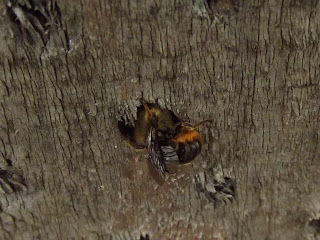One of my bee hotels with some holes used by bees last year. The capped ones are individuals haven't emerged yet. While some of the nests have small holes that could be either where the original occupant has emerged or its patrasitoid has come out, or even where a predator has broken in. The debris below the log is where bees have started clearing the holes for using this year.
Possibly and Andrena sp. of mason bee making its nest.
Mason bee again....
and again. This photo shows the hairy underside which is used to trap and hence transport pollen by this species of bee. The males do not have this as they do not play any part in constructing and provisioning the nests. In contrast, several photos down is a relatively hairless bee, one of the Hylaeus sp.
One of the Gasteruption sp. of mason bee parasitoids investigating a nest hole and a mason bee building a nest in another hole.
The Gasteruption again.
A green and red Cuckoo Wasp, perhaps Chrisis ignata, serching for mason bee nests in which to lay her eggs. Cuckoo Wasps are parasitoids of Mason Bees. they lay their eggs in the nests of the Mason Bees. The Cuckoo Bee's eggs hatch and the subsequent larva feds on the Mason Bee larva and the food that has been placed in the nest by the mother Mason Bee for her young. hence the name Cuckoo Wasp!
An unidentified wasp or bee visiting the bee hotel.
Probably an Ancistricerus sp. of wasp. investigating a hole. Also called Potter Wasps.
This is probably one of the several Hylaeus species of bee. They are also called Yellow-faced Bees as they often have yellow or white markings on their faces. this one does not appear to have those but it does have yellowish tibia (the equivalent would be calves on humans) on at least its middle and back legs. These bees line and cap their nests with a cellophane-like substance which I assume is derived from plant tissue and their own saliva. It creates a translucent finish to the nest cap. These bees have relatively hair free legs and undersides hence, unlike most other species of bee, which carry pollen within specialised hairs on their legs, undersides or other parts of their bodies, these bees transport pollen and nectar within their digestive tract.
The cellophane-like nest caps of Hylaeus cells.
Other capped cells in my bee hotel.













No comments:
Post a Comment